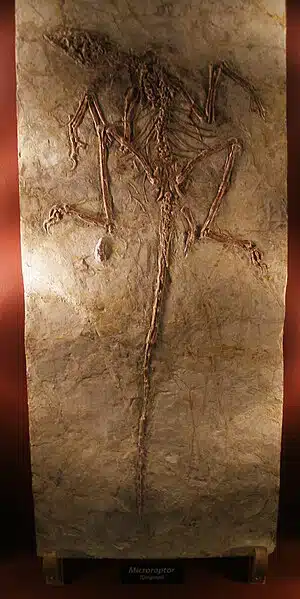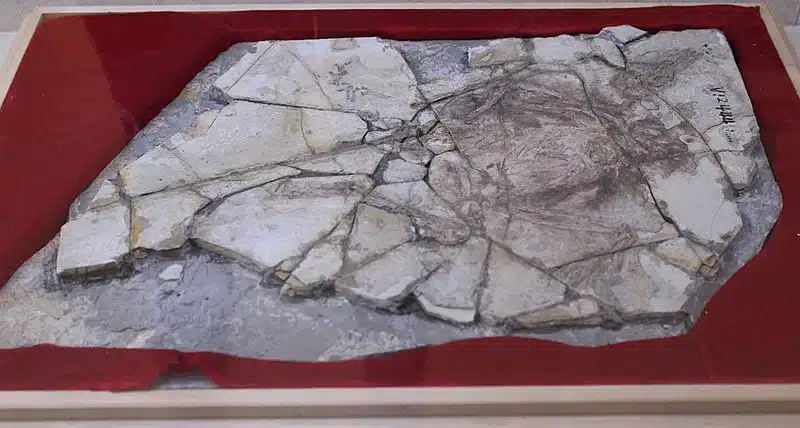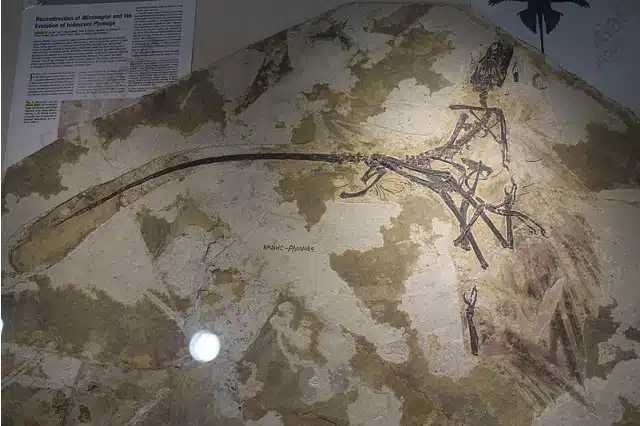The Microraptor was a diminutive yet intriguing member of the dinosaur community as its name suggests. Discovered in the early 21st century, it has since captivated the imagination of scientists and enthusiasts alike. Imagine a world where these creatures flitted through the forests of ancient China, a testament to the incredible diversity of life that once existed on our planet.
Microraptor Key Facts
| Keyword | Fact |
|---|---|
| Pronunciation | MIKE-row-rap-tor |
| Meaning of name | Small Thief |
| Group | Theropod |
| Type Species | Microraptor zhaoianus |
| Diet | Carnivore |
| When it Lived | 125.0 to 113.0 MYA |
| Period | Early Cretaceous |
| Epoch | Aptian |
| Length | 2.6 feet |
| Weight | 1.1 to 4.1 lbs |
| Mobility | Moved on two legs |
| First Discovery | 2000 by Xu Xing |
| Location of first find | Jiufotang Formation, Chaoyang, Liaoning, China |
| First Described by | 2000 by Xing Xu, Zhonghe Zhou& Xiaolin Wang |
| Holotype | V 12330 |
Microraptor Origins, Taxonomy and Timeline
The Microraptor has a name derived from Greek ‘micro’ and Latin ‘raptor’ meaning “Small Thief.” Its etymology reflects its diminutive size and predatory nature. Belonging to the Theropod group, this dino is part of the Dromaeosaurid family. The type species is Microraptor zhaoianus and there are two other species in the genus, M. gui and M. hanqingi.
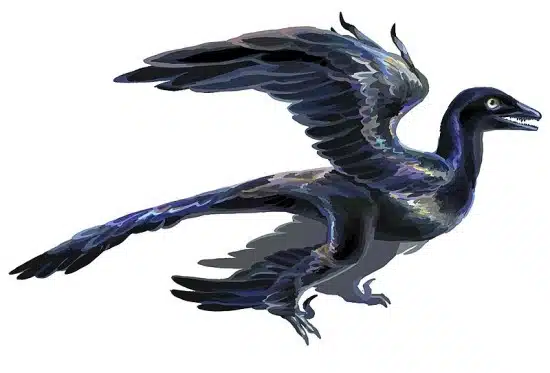
This small predator lived during the Early Cretaceous Period, specifically in the Aptian Epoch. Its existence occurred during a time when Asia was experiencing a sudden burst of igneous activity.
Discovery & Fossil Evidence
The discovery of Microraptor is a tale woven with controversy and rich fossil evidence. Initially, the first specimen was part of a chimeric concoction of different feathered dinosaurs. It was then smuggled into the USA. This led to a naming controversy when Storrs Olson, curator of birds at the Smithsonian Institution, named the Microraptor’s tail Archaeoraptor liaoningensis. This was an attempt to remove the name from the paleornithological record. However, Xu Xing, a paleontologist at Beijing’s Institute of Vertebrate Paleontology and Paleoanthropology, later described the complete specimen and named it Microraptor zhaoianus.
This is one of the most abundant non-avian dinosaurs in its ecosystem, represented by over 300 fossil specimens. These include the notable specimen BPM 1 3-13, initially named Cryptovolans pauli, which later studies revealed to be a junior synonym of Microraptor zhaoianus. Newer specimens have shown features like glossy-black iridescent plumage and a bifurcated tailfan, enriching our understanding of this species.
The abundance of Microraptor fossils, including those initially referred to as Cryptovolans pauli, has been instrumental in piecing together the life and habits of this intriguing dinosaur. Each new discovery adds another layer to the complex story of Microraptor. This makes it not just a subject of scientific study but also a fascinating narrative of paleontological detective work.
- OLYMPUS DIGITAL CAMERA
- Fossil specimen, with white arrows pointing at preserved feathers
- The “Archaeoraptor” fossil; the tail belongs to Microraptor
- Specimen at the Beijing Museum of Natural History
- Specimen in the Shandong Tianyu Museum of Nature
- M. gui holotype under two different UV light filters, revealing the extent of preserved feathers and soft tissue
Microraptor Size and Description
Now that we have an understanding of how this dinosaur came to be known, let’s delve into its physical characteristics. Despite its diminutive size, this dinosaur’s anatomy was both unique and fascinating.
Short Description of Microraptor
Microraptor was a small yet remarkable creature. Its streamlined body, slender neck, and series of vertebrae leading to a long tail all point to a life of agility and speed. The discovery of feather and wing impressions on several specimens has been a groundbreaking revelation that indicates a complexity in its physical makeup that continues to intrigue scientists.
Size and Weight of Type Species
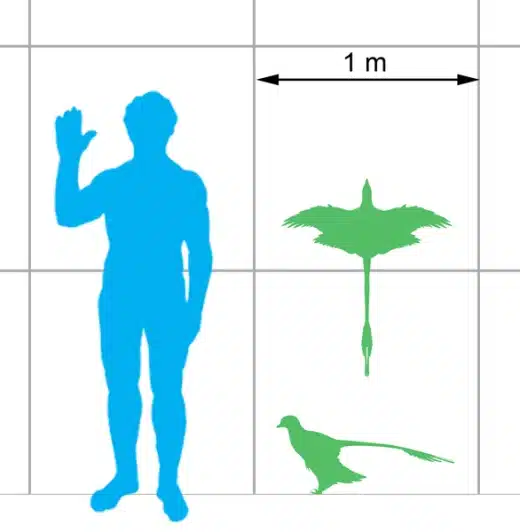
This was among the smallest-known non-avian dinosaurs of the Early Cretaceous. The holotype of the species M. gui measured approximately 2.53 feet in length with an estimated weight of 1.1 to 3.1 pounds. However, there are larger specimens that would have measured at least 2.6 feet in length, a wingspan exceeding 3.2 feet, and a weight between 2.8 and 4.1 pounds. These measurements highlight Microraptor’s status as a small, agile predator in the ancient forests it called home.
The Dinosaur in Detail
Much like the famous Archaeopteryx, this dinosaur offers pivotal evidence regarding the evolutionary link between birds and earlier dinosaurs. The well-preserved fossils are particularly noteworthy for their long feathers, which formed aerodynamic surfaces not just on the arms and tail but also on the legs. This unique feature led paleontologist Xu Xing in 2003 to describe the first specimen that preserved this characteristic as a “four-winged dinosaur.” He speculated that Microraptor might have used all four limbs to glide through the air. Further studies have even suggested that it was capable of powered flight, a remarkable capability that adds depth to our understanding of dinosaur evolution.
This carnivorous dinosaur had teeth that were a combination of serrated and non-serrated. Contents of meals found within the guts of fossil specimens suggest a diet of birds, lizards, early mammals, and even fish. It is possible that this was a nocturnal hunter due to the morphology of the eye, although its coloration suggests a more diurnal behavior.
The Ultimate Dino Quiz
Do you want to test your knowledge on dinosaurs? Then try this Ultimate Dino Quiz! Don’t worry if you get some of the answers wrong, and look at it as an opportunity to refresh and improve your knowledge!
Don’t forget to try our other games as well!
Interesting Points about Microraptor
- This is one of only two specimens of Theropod with confirmed stomach contents of an early mammal. The other is Sinosauropteryx.
- The coloration of its feathers may have resembled a modern starling.
- Its iridescent feathers were probably used in communication and mating behaviors.
- Over 300 specimens are known from this widespread genus.
- The holotype of this genus was a chimeric specimen that contained remains from Microraptor, Yanornis, and another unidentified species.
The Microraptor in its Natural Habitat
The natural world of Microraptor was one of ancient forests and diverse ecosystems. The presence of long aerodynamic feathers on all four limbs suggests a creature adept at navigating its forested environment, possibly gliding from tree to tree. This adaptation would have been crucial for both hunting and evading predators.
Its capability for powered flight, or at the very least, sophisticated gliding, indicates a complex interaction with its environment. It likely had a significant role in the ecosystem, possibly influencing the population dynamics of its prey and competing with other small predators. The abundance of fossils suggests that it was a successful species and well-adapted to the challenges of its habitat.
In this fertile, ancient world, Microraptor would have been a common sight. It was a testament to the incredible adaptability and diversity of life during the Cretaceous Period. Its evolutionary relationship with birds, its unique four-winged structure, and its prevalence in the fossil record all contribute to a fascinating portrait of this small but significant dinosaur.
Contemporary Dinosaurs
Picture this feathery dynamo, no larger than a modern crow, navigating a world where size often meant survival. Among its contemporary Asian dinosaurs, the Microraptor held a unique position in its ability to glide as well as in the intricate web of relationships it navigated daily.
Take the Sinornithosaurus, roughly the same size as our main dinosaur. These two might have engaged in a delicate dance of competition and coexistence. The Sinornithosaurus prowled the underbrush, perhaps eyeing the same insects or small vertebrates. At the same time, our Microraptor took to the trees and used its aerial advantage to scout and swoop down on unsuspecting prey. Their interactions were a testament to nature’s balance, where one’s strength complements the other’s weakness.
Then there was the Psittacosaurus, a creature quite different from our feathered protagonist. Larger and bound to the ground, this beaked herbivore likely paid little mind to the Microraptor and focused on tender shoots and leaves. Yet, in this prehistoric tapestry, even the indifferent relationships painted a picture. The Microraptor, agile and opportunistic, might have used its distraction as a cover to avoid larger predators.
Speaking of predators, the Jeholosaurus and Yixianosaurus, though not direct threats to the swift Microraptor, added layers to its daily existence. These contemporaries, larger and imposing, might have posed a threat in moments of desperation. Our Microraptor, ever the survivor, would dart through the foliage, a shadow among shadows, always aware, always adapting.
Frequently Asked Questions
Its initial discovery is unknown due to it being smuggled out of China in a fossil sale.
Its name has Greek and Latin origins and means “Small Thief.”
It was a carnivore that hunted small animals such as birds, lizards, early mammals, and even fish.
It was first found in the Jiufotang Formation, Chaoyang, Liaoning, China.
It moved on two legs and may have been capable of gliding or even powered flight.
It lived during the Early Cretaceous, around 125 to 113 MYA.
Sources
The information in this article is based on various sources, drawing on scientific research, fossil evidence, and expert analysis. The aim is to provide a comprehensive and accurate overview of the Microraptor. However, please be aware that our understanding of dinosaurs and their world is constantly evolving as new discoveries are made.
- https://web.archive.org/web/20081217154907/https://research.amnh.org/%7Esunny/microraptor.pdf
- https://doc.rero.ch/record/15275/files/PAL_E2574.pdf
- https://www.researchgate.net/publication/316776308_A_new_tiny_dromaeosaurid_dinosaur_from_the_Lower_Cretaceous_Jehol_Group_of_western_Liaoning_and_niche_differentiation_among_the_Jehol_dromaeosaurids
This article was last fact-checked: Joey Arboleda, 11-03-2023

